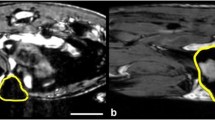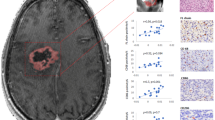Abstract
Background
The role of tumor-associated macrophages (TAMs) in glioblastoma (GBM) disease progression has received increasing attention. Recent advances have shown that TAMs can be re-programmed to exert a pro-inflammatory, anti-tumor effect to control GBMs. However, imaging methods capable of differentiating tumor progression from immunotherapy treatment effects have been lacking, making timely assessment of treatment response difficult. We showed that tracking monocytes using iron oxide nanoparticle (USPIO) with MRI can be a sensitive imaging method to detect therapy response directed at the innate immune system.
Methods
We implanted syngeneic mouse glioma stem cells into C57/BL6 mice and treated the animals with either niacin (a stimulator of innate immunity) or vehicle. Animals were imaged using an anatomical MRI sequence, R2* mapping, and quantitative susceptibility mapping (QSM) before and after USPIO injection.
Results
Compared to vehicles, niacin-treated animals showed significantly higher susceptibility and R2*, representing USPIO and monocyte infiltration into the tumor. We observed a significant reduction in tumor size in the niacin-treated group 7 days later. We validated our MRI results with flow cytometry and immunofluoresence, which showed that niacin decreased pro-inflammatory Ly6C high monocytes in the blood but increased CD16/32 pro-inflammatory macrophages within the tumor, consistent with migration of these pro-inflammatory innate immune cells from the blood to the tumor.
Conclusion
MRI with USPIO injection can detect therapeutic responses of innate immune stimulating agents before changes in tumor size have occurred, providing a potential complementary imaging technique to monitor cancer immunotherapies.
Manuscript highlight
We show that iron oxide nanoparticles (USPIOs) can be used to label innate immune cells and detect the trafficking of pro-inflammatory monocytes into the glioblastoma. This preceded changes in tumor size, making it a more sensitive imaging technique.







Similar content being viewed by others
References
Louis DN, Perry A, Wesseling P et al (2021) The 2021 WHO classification of tumors of the central nervous system: a summary. Neuro Oncol 23:1231–1251. https://doi.org/10.1093/neuonc/noab106
Parada LF, Dirks PB, Wechsler-Reya RJ (2017) Brain tumor stem cells remain in play. J Clin Oncol 35:2428–2431. https://doi.org/10.1200/JCO.2017.73.9540
Neftel C, Laffy J, Filbin MG et al (2019) An integrative model of cellular states, plasticity, and genetics for glioblastoma. Cell 178(835–49):e21. https://doi.org/10.1016/j.cell.2019.06.024
Mirzaei R, Gordon A, Zemp FJ et al (2021) PD-1 independent of PD-L1 ligation promotes glioblastoma growth through the NFkappaB pathway. Sci Adv. 7(eabh2):148. https://doi.org/10.1126/sciadv.abh2148
Osuka S, Van Meir EG (2017) Overcoming therapeutic resistance in glioblastoma: the way forward. J Clin Investig 127:415–426. https://doi.org/10.1172/JCI89587
Walczak TS, Williams DT, Berten W (1994) Utility and reliability of placebo infusion in the evaluation of patients with seizures. Neurology 44:394–399. https://doi.org/10.1212/wnl.44.3_part_1.394
Kantoff PW, Higano CS, Shore ND et al (2010) Sipuleucel-T immunotherapy for castration-resistant prostate cancer. N Engl J Med 363:411–422. https://doi.org/10.1056/NEJMoa1001294
Larkin J, Chiarion-Sileni V, Gonzalez R et al (2019) Five-year survival with combined nivolumab and ipilimumab in advanced melanoma. N Engl J Med 381:1535–1546. https://doi.org/10.1056/NEJMoa1910836
Mok TSK, Wu YL, Kudaba I et al (2019) Pembrolizumab versus chemotherapy for previously untreated, PD-L1-expressing, locally advanced or metastatic non-small-cell lung cancer (KEYNOTE-042): a randomised, open-label, controlled, phase 3 trial. Lancet 393:1819–1830. https://doi.org/10.1016/S0140-6736(18)32409-7
Hellmann MD, Paz-Ares L, Bernabe Caro R et al (2019) Nivolumab plus Ipilimumab in advanced non-small-cell lung cancer. N Engl J Med 381:2020–2031. https://doi.org/10.1056/NEJMoa1910231
Reardona D, Omuroa A, Brandes A et al. (2017) Randomized phase 3 study evaluating the efficacy and safety of nivolumab Vs bevacizumab in patients with recurrent glioblastoma: checkmate 143. Neuro-Oncology. OXFORD UNIV PRESS INC JOURNALS DEPT, 2001 EVANS RD, CARY, NC 27513 USA. pp. 21-
Sampson JH, Omuro AMP, Preusser M et al. (2016) A randomized, phase 3, open-label study of nivolumab versus temozolomide (TMZ) in combination with radiotherapy (RT) in adult patients (pts) with newly diagnosed, O-6-methylguanine DNA methyltransferase (MGMT)-unmethylated glioblastoma (GBM): CheckMate-498. American Society of Clinical Oncology
Han S, Ma E, Wang X, Yu C, Dong T, Zhan W, Wei X, Liang G, Feng S (2016) Rescuing defective tumor-infiltrating T-cell proliferation in glioblastoma patients. Oncol Lett 12:2924–2929. https://doi.org/10.3892/ol.2016.4944
Hodges TR, Ott M, Xiu J et al (2017) Mutational burden, immune checkpoint expression, and mismatch repair in glioma: implications for immune checkpoint immunotherapy. Neuro Oncol 19:1047–1057. https://doi.org/10.1093/neuonc/nox026
Friebel E, Kapolou K, Unger S et al (2020) Single-Cell Mapping of Human Brain Cancer Reveals Tumor-Specific Instruction of Tissue-Invading Leukocytes. Cell 181(1626–42):e20. https://doi.org/10.1016/j.cell.2020.04.055
Klemm F, Maas RR, Bowman RL et al (2020) Interrogation of the microenvironmental landscape in brain tumors reveals disease-specific alterations of immune cells. Cell 181(1643–60):e17. https://doi.org/10.1016/j.cell.2020.05.007
Mirzaei R, Sarkar S, Yong VW (2017) T cell exhaustion in glioblastoma: intricacies of immune checkpoints. Trends Immunol 38:104–115. https://doi.org/10.1016/j.it.2016.11.005
Gangoso E, Southgate B, Bradley L et al (2021) Glioblastomas acquire myeloid-affiliated transcriptional programs via epigenetic immunoediting to elicit immune evasion. Cell 184(2454–70):e26. https://doi.org/10.1016/j.cell.2021.03.023
Sarkar S, Doring A, Zemp FJ et al (2014) Therapeutic activation of macrophages and microglia to suppress brain tumor-initiating cells. Nat Neurosci 17:46–55. https://doi.org/10.1038/nn.3597
Sarkar S, Yang R, Mirzaei R et al (2020) Control of brain tumor growth by reactivating myeloid cells with niacin. Sci Transl Med. https://doi.org/10.1126/scitranslmed.aay9924
Okada H, Weller M, Huang R et al (2015) Immunotherapy response assessment in neuro-oncology: a report of the RANO working group. Lancet Oncol 16:e534–e542. https://doi.org/10.1016/S1470-2045(15)00088-1
Wen PY, Macdonald DR, Reardon DA et al (2010) Updated response assessment criteria for high-grade gliomas: response assessment in neuro-oncology working group. J Clin Oncol 28:1963–1972. https://doi.org/10.1200/JCO.2009.26.3541
Stupp R, Taillibert S, Kanner A et al (2017) Effect of tumor-treating fields plus maintenance temozolomide vs maintenance temozolomide alone on survival in patients with glioblastoma: a randomized clinical trial. JAMA 318:2306–2316. https://doi.org/10.1001/jama.2017.18718
Stupp R, Mason WP, van den Bent MJ et al (2005) Radiotherapy plus concomitant and adjuvant temozolomide for glioblastoma. N Engl J Med 352:987–996. https://doi.org/10.1056/NEJMoa043330
Namkung S, Zech CJ, Helmberger T, Reiser MF, Schoenberg SO (2007) Superparamagnetic iron oxide (SPIO)-enhanced liver MRI with ferucarbotran: efficacy for characterization of focal liver lesions. J Magn Reson Imag JMRI 25:755–765. https://doi.org/10.1002/jmri.20873
Takahama K, Amano Y, Hayashi H, Ishihara M, Kumazaki T (2003) Detection and characterization of focal liver lesions using superparamagnetic iron oxide-enhanced magnetic resonance imaging: comparison between ferumoxides-enhanced T1-weighted imaging and delayed-phase gadolinium-enhanced T1-weighted imaging. Abdom Imag 28:525–530
Hetzel D, Strauss W, Bernard K, Li Z, Urboniene A, Allen LF (2014) A Phase III, randomized, open-label trial of ferumoxytol compared with iron sucrose for the treatment of iron deficiency anemia in patients with a history of unsatisfactory oral iron therapy. Am J Hematol 89:646–650. https://doi.org/10.1002/ajh.23712
Spinowitz BS, Kausz AT, Baptista J, Noble SD, Sothinathan R, Bernardo MV, Brenner L, Pereira BJ (2008) Ferumoxytol for treating iron deficiency anemia in CKD. J Am Soc Nephrol 19:1599–1605. https://doi.org/10.1681/ASN.2007101156
Korchinski DJ, Taha M, Yang R, Nathoo N, Dunn JF (2015) Iron oxide as an mri contrast agent for cell tracking. Magn Reson Insights 8:15–29. https://doi.org/10.4137/MRI.S23557
Haacke EM, Liu S, Buch S, Zheng W, Wu D, Ye Y (2015) Quantitative susceptibility mapping: current status and future directions. Magn Reson Imaging 33:1–25. https://doi.org/10.1016/j.mri.2014.09.004
Vellinga MM, Vrenken H, Hulst HE, Polman CH, Uitdehaag BM, Pouwels PJ, Barkhof F, Geurts JJ (2009) Use of ultrasmall superparamagnetic particles of iron oxide (USPIO)-enhanced MRI to demonstrate diffuse inflammation in the normal-appearing white matter (NAWM) of multiple sclerosis (MS) patients: an exploratory study. J Magn Reson Imag: JMRI 29:774–779. https://doi.org/10.1002/jmri.21678
Zanganeh S, Hutter G, Spitler R et al (2016) Iron oxide nanoparticles inhibit tumour growth by inducing pro-inflammatory macrophage polarization in tumour tissues. Nat Nanotechnol 11:986–994. https://doi.org/10.1038/nnano.2016.168
Yang R, Sarkar S, Korchinski DJ, Wu Y, Yong VW, Dunn JF (2017) MRI monitoring of monocytes to detect immune stimulating treatment response in brain tumor. Neuro Oncol 19:364–371. https://doi.org/10.1093/neuonc/now180
Pisklakova A, McKenzie B, Zemp F et al (2016) M011L-deficient oncolytic myxoma virus induces apoptosis in brain tumor-initiating cells and enhances survival in a novel immunocompetent mouse model of glioblastoma. Neuro Oncol 18:1088–1098. https://doi.org/10.1093/neuonc/now006
Sun H, Wilman AH (2013) Background field removal using spherical mean value filtering and Tikhonov regularization. Magn Reson Med 71:1151–1157. https://doi.org/10.1002/mrm.24765
Li W, Wang N, Yu F, Han H, Cao W, Romero R, Tantiwongkosi B, Duong TQ, Liu C (2014) A method for estimating and removing streaking artifacts in quantitative susceptibility mapping. Neuroimage 108:111–122
Shin SH, Park SH, Kim SW, Kim M, Kim D (2017) Fluorine MR imaging monitoring of tumor inflammation after high-intensity focused ultrasound ablation. Radiology. https://doi.org/10.1148/radiol.2017171603
Weibel S, Basse-Luesebrink TC, Hess M et al (2013) Imaging of intratumoral inflammation during oncolytic virotherapy of tumors by 19F-magnetic resonance imaging (MRI). PLoS ONE 8:e56317. https://doi.org/10.1371/journal.pone.0056317
Aslan K, Turco V, Blobner J et al (2020) Heterogeneity of response to immune checkpoint blockade in hypermutated experimental gliomas. Nat Commun 11:931. https://doi.org/10.1038/s41467-020-14642-0
Orillion A, Hashimoto A, Damayanti N et al (2017) Entinostat neutralizes myeloid-derived suppressor cells and enhances the antitumor effect of PD-1 inhibition in murine models of lung and renal cell carcinoma. Clin Cancer Res 23:5187–5201. https://doi.org/10.1158/1078-0432.CCR-17-0741
Acknowledgements
This work is funded by an Alberta Innovates Health Solutions – Alberta Cancer Foundations Collaborative Research and Innovation Opportunities grant and by the Canadian Institutes of Health Research. KSR was supported by a Vanier Canada Graduate Scholarship, a Dr. T. Chen Fong Doctoral Scholarship, as well as a doctoral studentship from the Multiple Sclerosis Society of Canada.
Author information
Authors and Affiliations
Corresponding author
Ethics declarations
Conflict of interest
The authors declare no conflict of interests.
Additional information
Publisher's Note
Springer Nature remains neutral with regard to jurisdictional claims in published maps and institutional affiliations.
Electronic supplementary material
Below is the link to the electronic supplementary material.
Appendix
Appendix
Diagram detailing the main MRI experiment. Three animals died (two in vehicle, one in niacin) prior to day 35 and thus could not be imaged on day 35.

Rights and permissions
Springer Nature or its licensor holds exclusive rights to this article under a publishing agreement with the author(s) or other rightsholder(s); author self-archiving of the accepted manuscript version of this article is solely governed by the terms of such publishing agreement and applicable law.
About this article
Cite this article
Yang, R., Hamilton, A.M., Sun, H. et al. Detecting monocyte trafficking in an animal model of glioblastoma using R2* and quantitative susceptibility mapping. Cancer Immunol Immunother 72, 733–742 (2023). https://doi.org/10.1007/s00262-022-03297-z
Received:
Accepted:
Published:
Issue Date:
DOI: https://doi.org/10.1007/s00262-022-03297-z




